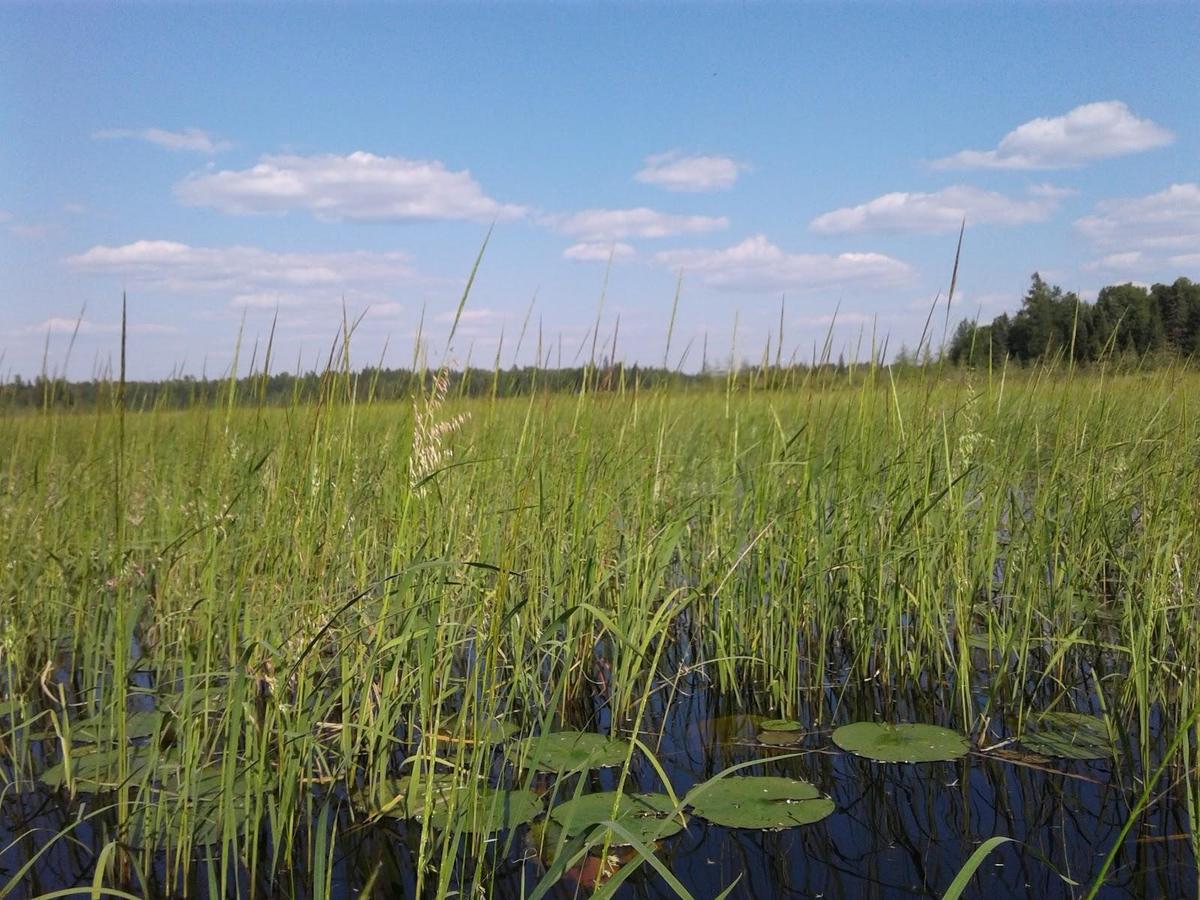Sulfate Treatment System
Sulfate is historically low in Northern Minnesotan freshwater system. Anthropogenic sulfate introduction to these low-sulfate waters can have potential adverse impacts for human and ecosystem health. Our research team has been developing alternative treatment systems to reduce sulfate level to waterbody: bioelectrochemical reactors and sulfide removal by iron-bearing minerals in mining waste streams.
Bioelectrochemical Reactors
M.S. students Tobin Deen and Dan Takaki have been developing bioelectrochemical reactors to biologically reduce sulfate and capture it as iron sulfide solid. They have constructed lab-scale batch and flow-through bioreactors and examined the efficacy of sulfate removal and microbial communities associated with sulfate removal using industrial wastewaters through experimental and mathematical modeling approaches.
Both Tobin and Dan presented their research at MN Water Resources Conference, Society of Environmental Toxicology and Chemistry North America Annual Meeting and American Chemical Society National Meeting. The project has been funded from USGS Water Resource Annual Grant Competition, UMN MnDRIVE, and NRRI Mining Innovation Grant.
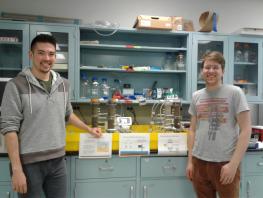
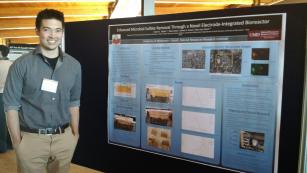
Tobin Deen and Dan Takaki with flow-through bioelectrochemical reactors for sulfate treatment (left) and Dan Takaki with his poster at St. Louis River Summit (Right)
Sulfide removal by iron-bearing minerals in mining waste streams
Biological sulfate removal has the potential to be very cost effective and versatile in terms of applications. The most common biologically-mediated sulfate removal process occurs in two steps. First, sulfate is reduced to sulfide by dissimilatory sulfate reducers. Subsequently, sulfide is immobilized by precipitation with a dissolved metal. Currently, effective sulfide capture methods remain a challenge that stands in the way of widespread adoption of biological sulfate treatment.
One known sink for sulfide is iron. Waste rocks from iron-rich mines contain a multitude of iron-bearing minerals including goethite, hematite, magnetite, siderite, ilmenite, and olivine. This project has investigated potential to use different iron-rich mining waste rocks in sulfur-capture systems within industrial discharge streams. This project is collaborated with Dr. Nate Johnson in our department and Dr. Lee Penn in the Department of Chemistry at University of Minnesota Twin Cities. Jake Daire, a M.S. student co-advised by Dr. Chun and Dr. Johnson, has examined iron liberation and sulfide removal capacities of various iron-bearing mineral nano- and micro-sized minerals using batch and column experiments. The project is funded by Mining Innovation Grant from Natural Resources Research Institute.
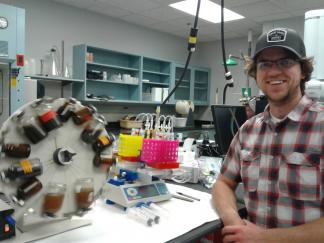
Jake Daire is working on iron liberation from iron-bearing minerals using batch and column experiments.
Microbial community associated with wild rice and invasive species
Wild rice (Zizania palustris) is an ecologically and culturally important plant in Minnesota and its state grain. Wild rice was historically abundant in northern Minnesota but its abundance and distribution have been reduced due to environmental contaminants, habitat destruction, physical disturbance, and establishment of competitive or invasive plant species.
Recently, our research team received Legislative-Citizen Commission on Minnesota Resources (LCCMR) funding to examine microbial and nutrient associations in self-sustaining wild rice wetlands for three years. The information is applied to develop a management strategy to promote restoration success in the St. Louis River estuary and wild rice lakes in Minnesota. The research project is conducted by M.S. student, Tyler Untiedt with assistance from an undergraduate student, Kim Hanson (Bridges to the Baccalaureate Degree Program). We conducted initial field sampling early fall in 2017 and are looking forward to productive field sampling as it gets warmer. We are collaborated with Biology and NRRI at UMD, MNDNR, Fond du Lac Department of Natural Resources, 1854 Treaty Authority, and St. Louis River Alliance.
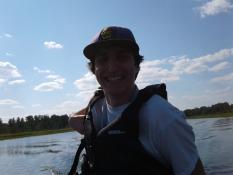
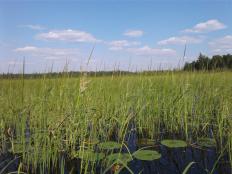
Tyler Untiedt is canoeing in headwater of St. Louis River (Skibo Landing) to collect water, sediment, and plant samples (Left) and self-sustaining wild rice stand in Skibo Landing.
Antibiotic Resistance in Sewer Systems
The continuous release of antibiotics to environment potentially results in an increase in natural resistance background levels which leads the rising numbers of bacterial pathogens becoming resistant against single or multiple antibiotics. Elevated levels of antibiotic resistance genes in wastewater effluents has been reported and it may be best is to reduce the amount of antibiotics and their resistance that reach a treatment plant in the first place.
Our research group has investigated the levels of antibiotic resistance in residential, hospital, and industrial sewages which enter Western Lake Superior Sanitary District wastewater treatment (WLSSD) in Duluth, Minnesota, with the collaboration with Dr. Adrian Hanson. Sara Constantine, an undergraduate student who was recently graduated from our department initially conducted the research as an Undergraduate Research Opportunity Program project with our research team.
Sara presented our findings at ASM International Conference on Innovative Microbial Ecology for Mitigation of Antibacterial Resistance and Bacterial Disease. She is working as an associate project manager in Minnesota Energy Resources. We want to acknowledge and appreciate the support and consultation from the City of Duluth (Todd Carson, Chris Keist, and crews), the City of Cloquet (Caleb Peterson, Eric Saboe, and crews), Essentia Health (Steve Waring and Dan Dauner), WLSSD (Joe Mayasich and Julie Macor), Industries (anonymous), College of Pharmacy (Grant Anderson) at UMD. A new graduate student, Adelle Schuman is joining our lab to examine the dynamic nature of microbial communities and functions associated with antibiotic resistance and explore potential mitigation strategies as a M.S student.
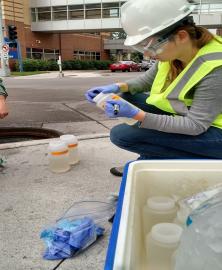
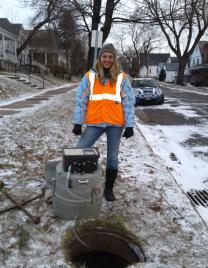
Sara Constantine is taking hospital sewer samples (left) and Adell Schumann is setting up ISCO sampler in residential site (outside temperature was around -5 ͒F and sewer temperature was around 45 ͒F during the sampling) (right)
Learn more about the Department of Civil Engineering.
Visit the Natural Resources Research Institute.
